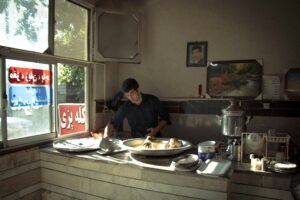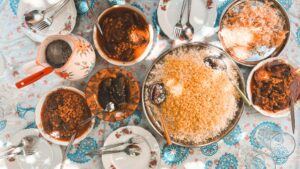By: Leila Modirzadeh, Research Executive

Photo 1: A local cook making broth
Over the course of the last few weeks, if not months, news from Iran has been making the headlines for a myriad of reasons: ranging from missile attacks by IAMGs exacerbating tensions in the region, plots to kill dissidents abroad and executing political prisoners, leaving very little room, if any, for Iranians to voice their opinions publicly.
In the last 6 months, ORB International has been researching public opinion in Iran, asking respondents from all regions, ages and ethnicities about their perspectives on various aspects of their lives. Be it surveys or Focus Groups, no data has been free from one topic: the rising price of meat.
Surging Meat Prices
Using the rising cost of meat as a quality-of-life indicator could strike some as unusual, but with the rising rates of inflation along with the continued economic sanctions on Iran, it plays a pivotal role not only in the living standards of Iranians but also Iranian culture and cuisine. Considering that the national dish (Ghorme Sabzi), amongst many, is primarily meat-based this proves particularly significant. In 2023, inflation rates went up at a high of 47.01% in Iran, compared to 45.75% in 2021 and 40.21% in 20191. Whilst the high rates of inflation have also impeded Iranians’ access to medicine, housing security and basic amenities, reports by the Meat and Protein Industry Association of Iran indicate that meat consumption decreased by 50 per cent last year as a result2.
Indeed, our data shows that Iranians believe that more internal spending should be put into tackling these issues, not an easy task while Iran continues to invest in supporting armed groups spread across the region. Data also shows that Iranians are aware of their government’s priorities in this respect.
When asked about their personal experiences of the economic situation, Iranians see the cost of meat as an indication of the erosion of the middle class and widening inequalities. They often compare the cuts of meat they were once able to afford, to now having to buy less for more. Those from lower socio-economic backgrounds were even said to have to buy chicken feet as a substitute.

Photo 2: A Persian Dinner
Future Economic Impacts
Whilst there are significant differences in food security and the provision of services amongst different regions, the ability to afford produce central to the Iranian diet, such as fruits and nuts, has also declined. Our findings show that Iranians are increasingly having to limit their spending on different fresh fruits and vegetables each week to make up for the increase in prices. This rise in food insecurity also carries cultural and social repercussions, particularly with Ramadan and Persian New Year around the corner, times of year when Iranians take a lot of pride in hosting meals, with dishes such as Ghorme Sabzi and Chelo Kabab often served on the table.
Though inflation has been experienced across all parts of the world, it is evident that increasing tensions in the region and proxy wars, in addition to economic sanctions imposed on the Iranian government have led to a rise in food insecurity. In future research, ORB aims to explore Iranian citizens confidence in their government’s ability to reprioritise and focus on Iranians needs rather than external conflicts and power rush.
______________________________________
1 Iran: Inflation rate from 1987 to 2028 │Statista
2 Meat Prices Reach New Highs In Iran, Consumption Down by 50 Percent │ Iran International
